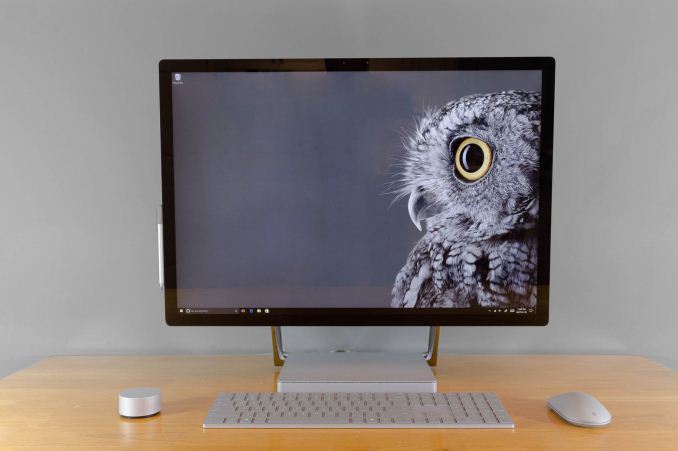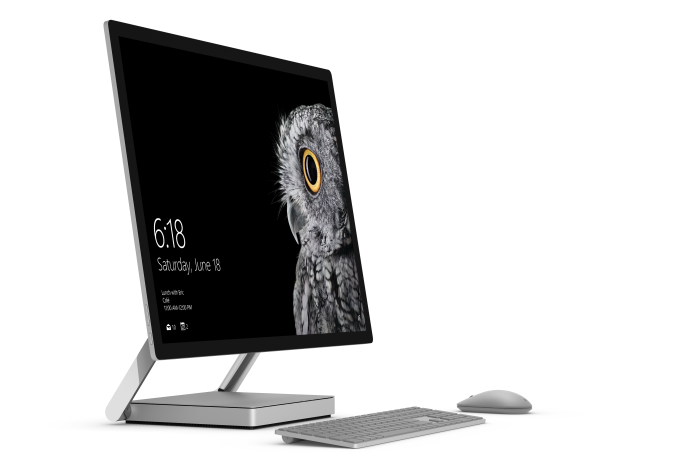The Microsoft Surface Studio Review
by Brett Howse on January 20, 2017 8:00 AM EST- Posted in
- Desktop
- Microsoft
- Surface
- Surface Studio

Microsoft has only been in the PC system game for a few years now, but over the last couple of years they have made a lot of progress rather quickly. These days they have a solid foundation of products available, with the Surface Pro 4 being one of the best convertible tablets, the Surface Book being a very solid convertible laptop, and also the more specialized products like the Hololens, and Surface Hub. Going into their October 2016 event, the one missing piece of their PC product lineup was a desktop computer, but with the announcement and release of the Surface Studio, that particular gap has now been filled.
But the Surface Studio is not your typical desktop PC. Even at first glance, the sleek, beautiful lines are readily apparent, and once powered on, it is rare for anyone to first glimpse the 28.125-inch 4500x3000 display and not say “wow”. It’s not only the very high resolution, but also the 3:2 aspect ratio that is unheard of in this segment, that makes the display stand out as something unique.
Microsoft has become one of the superlative hardware manufacturers in only the short span of four years or so, and the Surface Studio is one of their finest designs yet. However, from the very first Surface RT, Microsoft always tries to add something different, but more importantly interesting, to their designs, and in the case of the Surface Studio, it is the zero-gravity hinge, which allows the all-in-one to be quickly and easily tilted back to a 20° angle, letting it be used as a huge, digital drafting table. Microsoft announced the Surface Studio at their October Windows event, where they also announced the next Windows 10 Update, called the Creator’s Update, and it is wonderful to see them building hardware to truly bring out the exclusive features of their software.
Packed into the base of the Surface Studio is a laptop-class computer, with three different models available now. The base model, coming in at $2999, features an Intel Core i5-6440HQ processor, 8 GB of memory, a 1 TB hybrid drive with a 64 GB SSD cache, and a NVIDIA GeForce GTX 965M GPU. The mid-level model, which costs $3499, bumps the CPU up to an Intel Core i7-6820HQ, doubles the RAM to 16 GB, and doubles the SSD cache to a PCIe 128 GB model, with the same 1 TB HDD and GTX 965M. The highest priced model, at $4199, is an Intel Core i7-6820HQ, 32 GB of RAM, a 2 TB hybrid drive with a 128 GB PCIe cache, and a NVIDIA GTX 980M GPU with 4 GB of memory.
| Microsoft Surface Studio | ||||||
| Base | Middle | Top (As Tested) | ||||
| CPU | Intel Core i5-6440HQ Quad-Core, 2.6-3.5 GHz 6 MB Cache, 45W TDP, No Hyperthreading |
Intel Core i7-6820HQ Quad-Core, 2.7-3.6 GHz 8 MB Cache, 45W TDP, Hyperthreading |
||||
| GPU | NVIDIA GTX 965M 1024 CUDA Cores 944 Mhz + Boost 2 GB GDDR5 128-bit memory |
NVIDIA GTX 980M 1536 CUDA Cores 1038 Mhz + Boost 4 GB GDDR5 256-bit memory |
||||
| RAM | 8 GB DDR4 | 16 GB DDR4 | 32 GB DDR4 | |||
| Storage | 1 TB Hybrid Drive 64 GB SATA SSD Cache / 1 TB SATA HDD |
1 TB Hybrid Drive 128 GB PCIe SSD Cache / 1 TB SATA HDD |
2 TB Hybrid Drive 128 GB PCIe SSD Cache / 2 TB SATA HDD |
|||
| IO | 4 USB 3.0 ports - one high power port Full size SD Card Slot Headset Jack Xbox Wireless Connectivity DisplayPort |
|||||
| Display | 28.125-inch PixelSense Display 4500 x 3000 resolution 192 DPI sRGB, DCI-P3, P3 D65 color modes |
|||||
| Webcam | 5 MP Webcam Windows Hello Facial Recognition |
|||||
| Networking | Marvel AVASTAR 802.11ac Intel I219-LM Gigabit Ethernet |
|||||
| Price | $2,999 | $3,499 | $4,199 | |||
There was quite a bit of discussion at the time of the Surface Studio launch over the fact that it was equipped with older technology. Intel’s Kaby Lake quad-core parts just launched at CES this year, so Skylake quad-core CPUs were the latest generation available at launch. The Maxwell based graphics options chosen were not the latest generation mobile graphics from NVIDIA, with the GTX 965M and GTX 980M available in the Studio. The Pascal based GTX 1060 and GTX 1070 would have been much more powerful substitutes, but they are not pin-compatible drop-in components with the Maxwell GPUs in the Surface Studio, meaning a new board design and thermal considerations would have been necessary late in the design phase, and Microsoft appears to have been conservative here to avoid missing their launch window.
Microsoft has also been very conservative with their I/O choices, with four USB 3.0 Type-A ports on the back of the Studio, along with a SD card slot, and mini DisplayPort. As with the Surface Pro 4 and Surface Book, Microsoft has continued to provide only the older USB-A ports, and not even offer a single USB-C port, let alone with Thunderbolt. Anyone purchasing a Studio will likely be using it for several years, and the lack of USB-C is going to be an issue in the future, if not already today. The Surface team really needs to reconsider this as it is already a detriment to not include any.
There also must be some questions raised about the use of a hybrid drive in a PC of this price. We’ll dig in to the experience later, but Microsoft could and should offer a larger SSD as the boot disk, complimented by a HDD as a secondary disk, at least on the highest end model. A 512 GB NVMe SSD as the boot drive would appease much of the criticism. The computer does cost over $4000 after all, and while much of the cost of the device is in the display, SSDs have been the biggest improvement in user experience on the PC in a long time.











197 Comments
View All Comments
jlabelle2 - Monday, January 23, 2017 - link
if you have a wide gamut screen (wider than sRGB), then yes.That is why on Android, every screen with a wider gamut than sRGB is very bad.
Even on Windows, it is really a chore as most of the time is spent in web browser (some are color managed though like Firefox) or Windows app or standard programs which are not color managed.
Really, this toggle switch on the Studio is really the best solution so far on Windows (short of Microsoft implementing a system wide color management) and I wish they would allow that on any machine and let us store the ICC profile we want inside.
fanofanand - Monday, January 23, 2017 - link
"So, for example, what is a proper white point? Well, we really don't know. "In other words you are complaining that the author wasn't accurately describing true white point when you say yourself that nobody knows. Why do I get the feeling you just wanted a place to brag about your extensive understanding of color management? Why did you feel the need to cite the cost of your incredible monitor that no other monitor can touch? If you feel the need to lord your incredibly vast knowledge of sunlight please go find a digital photo community that might be more receptive to your ramblings and musings.
id4andrei - Friday, January 20, 2017 - link
You can switch colorspaces on the fly. Not ideal, as the review already mentioned, but good enough for now. Furthermore this isn't exclusively targeted towards color sensitive work. Even simple document work benefits hugely from the form factor. Not to mention sketching/drawing.melgross - Friday, January 20, 2017 - link
It's not actually useful when doing precise color work, because you need both images on the screen at the same time, often enough. You do need to see how an Adobe RGB/HSB/Hex image looks after if been either converted to sRGB, or assigned an sRGB profile. No systemwide color mange,Win 10 means you can't do that. Well, not easily.jlabelle2 - Sunday, January 22, 2017 - link
If you are using a color managed application (like Photoshop), you can see both images (one in rRGB and the other in whatever color space), side by side.Your comment makes no sense. It is true that not all programs (and none of modern Store app) are color managed but for the one that are, there is no issue.
Brandon Chester - Friday, January 20, 2017 - link
It's not good enough for now, it's useless for a plethora of circumstances where wide color would be beneficial alongside existing sRGB content.jlabelle2 - Thursday, January 26, 2017 - link
Your wording is not precise enough Brandon. You can have sRGB content that is correctly displayed if it is from a color managed application.What you should say is that it is an issue for all apps and programs which are NOT color managed (irrespective of the content color space -except if it is by chance exactly matching the one from the screen-).
That is why, with this current limitation, at least, this switch on the Action Center is just the best solution I have seen on this, ever. Once you are done working with various gamut content en color managed applications (Photoshop, Lightroom, Capture One Pro, Irfanview, various video editors...) that display properly the content, you can switch to sRGB for web browsing, email, or other tasks using non color managed application.
vLsL2VnDmWjoTByaVLxb - Friday, January 20, 2017 - link
> "Windows 10 is the first Windows OS to have a working color management system built-in, but it comes turned off, because turning it on at this late stage screws up everything else in Windows, and it's very buggy."It isn't working, if it's buggy.
lilmoe - Friday, January 20, 2017 - link
I have three major issues with this PC:1) The base model. At that price they should have opted for the middle specs (6820HQ, 16GB of RAM), a 512GB NVMe SSD and non of the hybrid BS. Also the graphics card should have been the equivalent pro-grade Quadro which works better, and more reliable with the pro software this PC is aimed at. They should have also offered Mobile Xeon SKUs with ECC RAM.
2) Really? No USB-C and Thunderbolt 3? I mean, this IS the type of PC you'd want to connect an external GPU to, and/or other high performance peripherals. I mean, it IS dedicated to pros, right?
3) No HDMI/DP in. No matter how good this screen is, it's nothing more than junk 3-4 years later when the hardware in the base is obsolete.....
No good, Microsoft. The negatives far outweigh the positives.... It wont get any recommends from me to anyone who isn't interested in burning $$$$$.
Michael Bay - Saturday, January 21, 2017 - link
If last three years in CPUs is anything to go by, it will be just fine three years in the future.